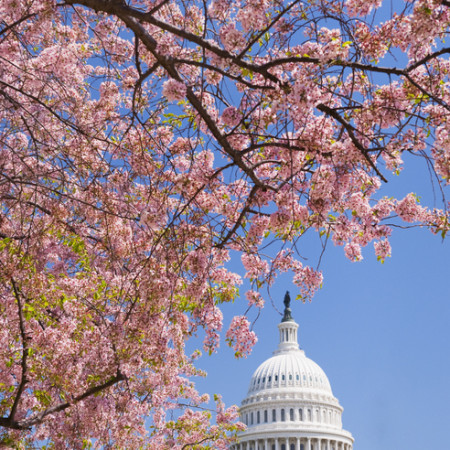At the end of July, while lawmakers bandied about budgetary policy and the news media obsessively reported on debt ceiling default scenarios that could push the US economy off of a “fiscal cliff,” I attended a Politico Women’s Rule briefing and learned about a completely different kind of policy “cliff” – one both alarming and underreported. It’s called the “child care cliff,” and here’s what I learned about it:
- An estimated 3.2 million kids are at risk of losing child care access as pandemic-era funding goes “poof” overnight on September 30th
- If it won’t affect you directly, it may well affect someone you know or someone who works at your company – and she’s likely a woman
- Its outcome will set the trajectory for larger policy debates and outcomes on child care, employer benefits, and the needs of working parents.
How Was the Cliff Created – and Why are We Teetering On the Edge?
Like so many recent funding and public policy decisions, the basis of the child care cliff is rooted in emergency action taken by Congress in the midst of the COVID-19 pandemic. Just like the restaurant, retail, and live entertainment sectors, the child care industry struggled to keep its doors open in 2020 and 2021. It faced a double whammy: 1. layoffs caused parents to pull kids out of paid child care, and 2. educational and kid-centric facilities were often closed due to teacher and student illness. This created an associated crisis for parents working in print manufacturing and other industries deemed essential during the pandemic. Parents were required to work, while the child care facilities they depended upon were shuttering at a rapid pace.
So, the Federal government stepped in to intercede. As part of national pandemic relief legislation, Congress created the Child Care and Development Block Grant (CCDBG) program as the primary mechanism to ensure child care access, while delivering money to child care providers through state funding. (This chart published by the First Five Years Fund provides details on funding levels.) The most recent emergency allocation to the CCDBG in March 2021 allocated nearly $24 billion of relief. That cash infusion, according to the US Department of Health and Human Services, reportedly kept 8 in 10 child care centers open and functioning.
But like the vast majority of other pandemic sector relief, the funding was temporary. In this case, the money runs out at the end of September of this year, 2023. Which means there’s roughly 30 days to prevent what could be both a devastating blow to early childhood education AND a gigantic headache for working parents as child care facilities run out of operating revenue.
The projection that over 3 million kids could be at risk of losing child care comes from a study by The Century Foundation (TCF). Detractors point out that the organization is considered left-leaning and question the voracity of the numbers. But even if the number is half what TCF has estimated, it could well affect you or a parent who works with or for you. That’s concern that should transcend partisan politics.
Short-Term Answers: What Policy Actions Can Bring Us Back from the Edge?
The immediate solution to pull the nation back from the edge of the child care cliff is for Congress to extend the expiring funding to prevent the gap that starts in October. House and Senate Democrats on July 31 called for President Biden to approve $16 billion in emergency supplemental spending to address this looming cliff. While it’s the most straightforward approach, it also throws child care into a mix of competing budget priorities, such as Ukraine and Hawaiian wildfire relief. Whether or not Congress approves such funding as part of a potential short-term funding bill for fiscal year (FY) 2024 is still anyone’s guess.
Other solutions as outlined in a recent Politico article, include stand-alone legislation or inclusion of child care funding as part of a larger tax relief bill. The tax legislation approach might include language contained in a bipartisan bill designed to incentivize private sector employers to play a larger role in addressing child care access. The bill introduced in July by Representatives Carbajal, D-CA, and Chavez-DeRemer, R-OR, has already garnered endorsements by the US Chamber of Commerce and Save the Children. There’s also widespread public support for the bill’s provisions, according to a poll commissioned by First Five Years Fund.
However, all of these potential solutions take time and have uncertain fates given the partisan divide in the U.S. House and Senate. And, simply extending funding will eventually lead us right back to another precipice. Thus, long-term policy solutions need to take root now, according to advocates on all sides of the political spectrum.
Long-Term Focus: Future Forward Policy Solutions
That’s the goal of two lawmakers, U.S. Representatives Nancy Mace (R-SC), a working mom and Ro Khanna (D-CA), a working dad who together launched the Congressional Bipartisan Affordable Childcare Caucus in June, and have hit the media circuit trying to raise awareness of the pending child care cliff. Both are realistic about the current partisan gridlock in Congress, but they are also motivated to elevate issues related to both the high cost and the diminishing access to child care. Both agree that seeking small, non-controversial changes, such as reforming training and certification reforms can eventually add up to make a big impact for working parents. The pair is also committed to changing the perception of child care so that policy makers, employers, and workers view it less as a “women’s issue” (particularly in a hyper-politicized, “post-Roe era,” according to Representative Mace) and more as an economic and labor market issue that diffuses partisanship.
Representative Khanna is also fond of pointing out that government and business worked together successfully decades ago to address a child care crisis. “We had universal child care in America in the 1940s,” Khanna said, evoking Rosie the Riveter images of WWII era women working in factories. “It worked. And it’s time to do it again.” He also is quick to call on private sector employers, led by Corporate America and high-tech companies headquartered in his Simi Valley, CA district to be partners in the policy debate.
How Can (and Why Should) the Print Industry Help Highlight Concerns about the Child Care Cliff?
In sounding the alarm bell that connects affordable, accessible child care cliff and U.S. jobs, Melissa Boteach, vice president at the National Women’s Law Center said, “It’s going to feel more like a slow roll, but then when the cumulative effect is in place, we’ll see that more women dropped out of the labor force; more businesses struggle to find people to hire; more children and families cannot find a slot. Why? Because we didn’t invest in child care.”
CEOs in the printing industry are primed to be natural spokespeople when it comes to reframing child care policy as an economic concern. Attracting women (often working mothers) is an increasingly necessary priority in the print industry, as an aging and traditionally male workforce retires and the industry looks to attract a more diverse pool of employees.
The printing industry has a considerable stake in the future of child care affordability and accessibility as a workforce issue – and should lean into the national conversation about private sector incentives and solutions. While small and mid-sized printing companies may not have the resources to devote to funding corporate day cares, they can still look for incremental, manageable, and budget-friendly ways to emulate or modify employer trends that better support working moms and parents.
There are three things leaders in the printing industry can do NOW in the face of the child care cliff to help prevent potential workforce disruptions. These include:
- Reach out to U.S. Senators and U.S. Representatives as soon as possible to urge them to make addressing the child care cliff a top priority before the end of FY 2023. (PRINTING United Alliance’s Legislative Advocacy Center is a great resource to find contact information for your lawmakers.)
- Assure employees who are working parents that company leadership is aware of this policy concern, and be sure such employees also have access to contact lawmakers to express their own desire for a solution. (The resource mentioned above is also open to employees of the industry.)
- Commit as a company to keeping tabs on how the child care cliff scenario unfolds, and look for opportunities to stay abreast of child care policy trends, innovative bests practices, and employee benefits that can aid working parents – because the issue isn’t going away. Your employees will feel seen and understood, which in turn will help your company culture become one of inclusiveness – which will encourage workforce retention.
Meanwhile, How Should Working Moms in the Printing Industry Prepare?
Color us unsurprised that experts predict the pending child care cliff will disproportionately impact working women, a population that dropped out of the labor market in droves during the height of the pandemic, primarily due to remote education, home schooling, and lack of affordable and available day care centers.
In its Data Deep Dive: The Decline of Women in the Workforce report, the U.S. Chamber of Commerce found that 58% of parents said child care was not accessible during the pandemic, while 26% reported that day care was unaffordable. Clearly, there’s a risk that more women could leave print and other industries, due to ramifications of a child care cliff, should the negative consequences come to fruition.
If you are a woman in print who is also a working mom with kids in day care, start talking about the pending challenge NOW to stay on top of the situation at home and at work. Specifically:
-
- Talk to your child’s day care provider to assess their dependency on CCDBG funding and the likelihood that you and your child may be impacted. Discuss alternate arrangements with the provider or with other parents who may be impacted.
- Talk to your manager or HR representative now if you are concerned that the pending child care cliff may impact your ability to be at work later this year. Share this article with them. This “heads up” approach can ensure company leadership is aware that this is a potential national and perhaps even company crisis, not one relegated to just you as a individual employee.
- Talk to your federal elected officials. Send an email or make a phone call to their offices to urge them to take action ASAP to prevent negative impacts for your family. (You can find contact info here.)
Candidly, even if the immediate problem is averted, the ongoing concern of access to affordable child care will remain a workforce issue. And as President Obama’s former chief of staff Rahm Emanuel once said, “Never let a serious crisis go to waste.” Attention (albeit way overdue) is about to get white hot on this topic. Now is an excellent time to initiate discussions with your employer that can benefit both the company and its employees who are parents of young or school-aged children.
What WON’T work is simply expecting your company to bail you out. Collaboration on workforce policy is key. So, offer to be part of an employee task force or focus group at your company to help inform HR and leadership of child care policy macro-needs and trends. Keep educated on the topic and help your company stay abreast of the issue by sharing examples of private sector engagement that may be applied or modified at your company. Who knows, you might just be the one to help your company and the industry launch changes that help fellow working women in print now and into the the future.
Most Importantly, How Can You Protect Your Child?
The most innocent victims in this situation may well be the children who must adjust to their child care centers closing. Motherly has compiled a good resource list that parents who lose day care options may wish to rely on to help keep their children feeling secure and in good spirits during an unplanned transition.
Stay Tuned as the Child Care Cliff Fast Approaches…
Women in Print Alliance will continue to monitor the policy and practical implications of the child care cliff as the September 30 deadline nears. We will join the chorus of business and industry voices calling upon Congress to pay attention to this potential national workforce and early education crisis before it’s too late.
They are already behind the proverbial eight ball. As Reshma Saujani, CEO of Mom’s First and founder of Girls Who Code, stated at Politico’s Women Rule briefing, “Congress acted faster on having Taylor Swift hearings on Ticketmaster than they have on the child care cliff, and that is absolutely unacceptable.”




